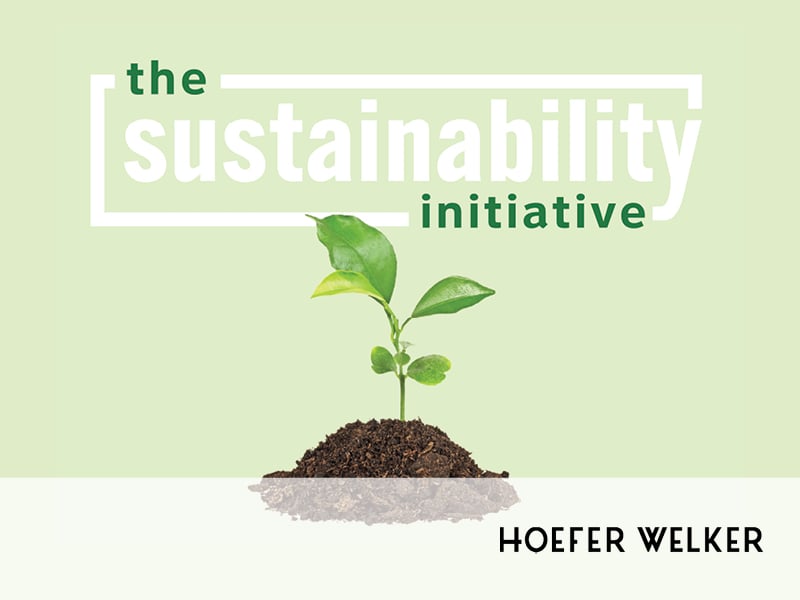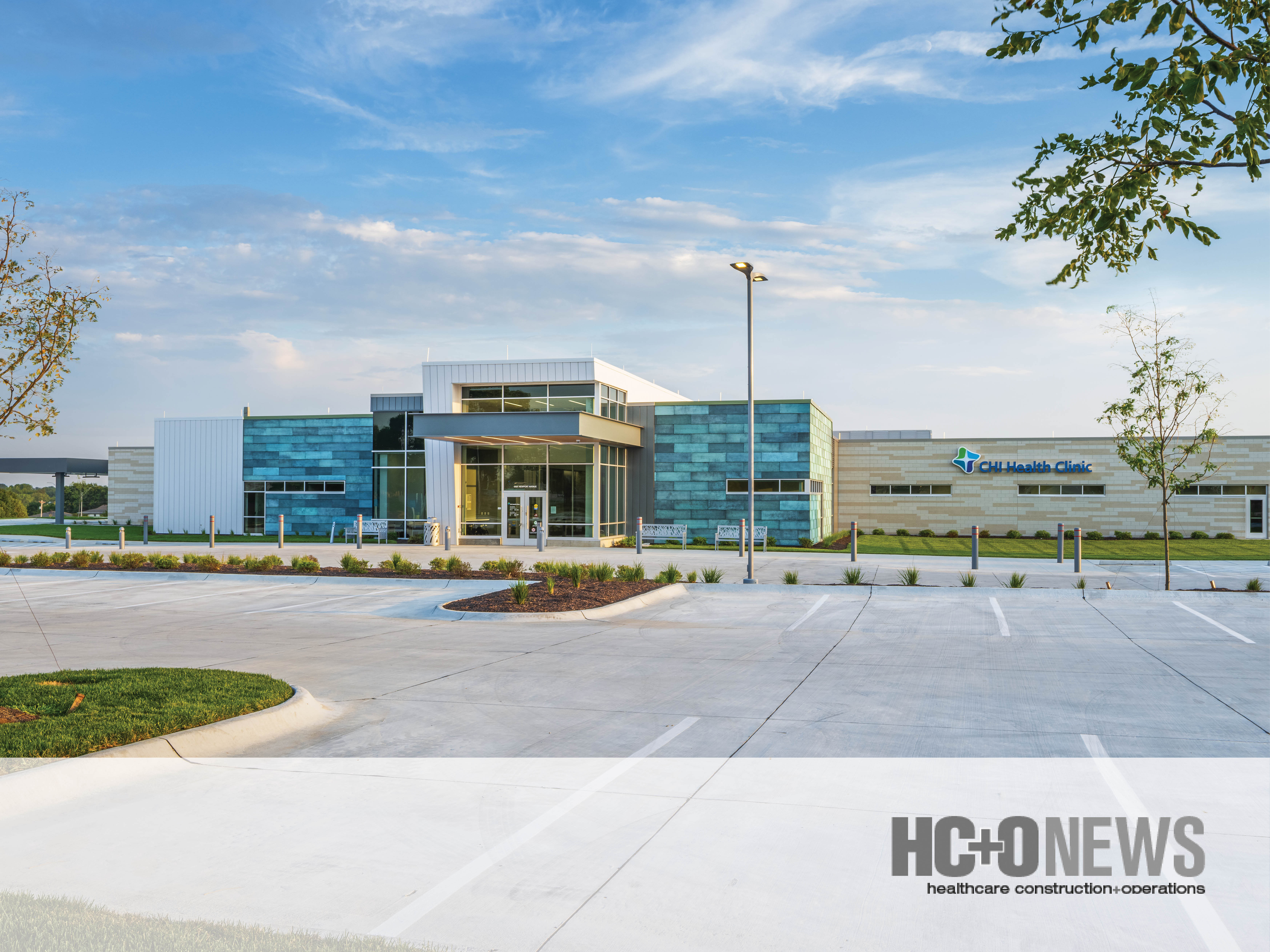Modular and Prefabricated Design Part I: The New Mainstream for Health Systems
A recent HCO News article highlights how modular and prefabricated design is becoming a mainstream solution for healthcare systems facing rising...

With Earth Day around the corner, Hoefer Welker encourages clients, project stakeholders, fellow architects, engineers, and designers to embark on a sustainability initiative. Now is the time to refresh your processes for selecting materials, ensuring they are sustainable and responsibly sourced.
As Hoefer Welker has pledged to create and build using resilient, human-centric, and ethically sourced products, we invite you to join our initiative by pledging to do the same. Determining goals that establish resilient practices and implement sustainable standards can be daunting at first, but don’t let perfection get in the way of creating something good.
Ashley Langenfeld, associate vice president and director of sustainability and the Green Team at Hoefer Welker, is at the forefront of initiating this process throughout each sector of the organization.
“No one in the industry is doing this perfectly but by being more aware, we can make better design decisions and help spur the industry to continue to improve,” Langenfeld stated. “That can look like many different things to each firm but we’ve crafted our own goals, mission statements, and initiatives for Hoefer Welker’s approach to this challenge."
Hoefer Welker also created a task force of Green Team members to deep-dive into each of the criteria, and the firm encourages you to do the same. “Not only does it give our employees more ownership of their material choices, but each individual offers new ideas and angles that build on each other. When we’re all done sharing ideas we end up with something far better than we ever thought was possible. The most important thing is to start. You may be surprised where it’ll take you.”
If you’re intrigued by taking a step but unsure where to start, Hoefer Welker’s Green Team has you covered. Here are five tips and tricks to consider when starting your sustainable material initiative journey!
It’s hard to make any change in any organization if the reason behind it isn’t understood. The first step is determining how the AIA Materials Pledge aligns with your company’s processes and goals. Jeremiah Vick, Healthcare Green Team leader, sees responsible material selection as just a part of being a responsible architectural designer.
“The AIA Materials Pledge is really just keeping us as architects accountable at being the most ethical we can be,” Vick notes. “We should be already considering the environment, user health and wellness, and how laborers are treated. It’s the logical next step forward for how we should be designing and considering the implications of all our decisions.”
Making the initiative personal to employees and their work helps further the adoption of material selection processes and changes in thought. It also fosters conversations that spark new ideas and further sharing of lessons learned.
Step you can take: Review the AIA Materials Pledge lens and your company’s mission statement to find synergies for easy first steps.

The most challenging step is moving forward from establishing your mission and goals to implementation. When approaching material selection in practice, it can be overwhelming to review the assortment of materials certifications. Even when reviewing the AIA Materials Pledge, the five lenses are complex enough that any designer could get lost. This was why Hoefer Welker elected to empower material selection champions and subject matter experts in each lens. By dividing and conquering, the team was able to take a large, difficult task and distill it into actionable, bite-sized chunks for designers.
Lily Ehler, one such subject matter expert from the Dallas office, noted the importance of this.
“My biggest lesson learned from this process is that dedicated research and firmwide education are critical. As designers, our education is never finished, and signing the AIA Materials Pledge provides a great opportunity to kick-start conversations on sustainability. Our Materials Pledge committee dove deep into researching each of the five aspects of the pledge. This allowed us to present a comprehensive overview to our peers, which spurred further firmwide discussion on what implementation looks like for Hoefer Welker.”
This valuable research eliminated action without purpose and fostered the development of long-term solutions.
Step you can take: Empower material selection champions to curate companywide education and awareness on material selection.
Education is important not only within your firm but also with key stakeholders, such as clients and manufacturers. For example, asking your manufacturer about their sustainable practices pushes the market to change via competition. Your firm is also more likely to be informed of the latest and greatest in sustainable material options.
Kara Koenig of the Interiors Green Team has witnessed this in their own practices. Any manufacturer trying to be included in Hoefer Welker’s finish library or coming in for a lunch and learn is questioned on their sustainable practices, and it has had great benefits for the firm.
“Don’t be afraid to ask your manufacturers’ reps questions,” she notes, “if we bring up that we are looking for sustainable logos and ingredients, they are more likely to present sustainable things to us in the future.
Kara also points to similar benefits when having discussions with clients. If your clients aren’t aware of what’s possible, material selection potential will only go so far.
“You have to learn how to sell sustainability,” Koenig explains. “For us, that looks like integrating this into our charrette processes early on in the project. Learning how to explain the value of sustainability right off the bat with clients will help show them the long-term benefits.”
Step you can take: >Choose one client to have a conversation with on the value of sustainable materials or one manufacturer on what sustainable aspects their materials have.

Materials selections have a lasting impact on human health and building performance. These decisions live beyond the design team throughout the life of the building. How will the materials be maintained? Will the chemicals in the materials affect the occupants? What will happen at the end of the materials’ life? These questions, among others, need to be considered in design for the good of the ongoing performance of a building.
Gracie Knight, the circular economy subject matter expert, points to a few things to ponder.
“Support a circular economy by preferring products that adhere to these three principles: designing out waste and pollution, keeping products and materials in use, and regenerating natural systems.” Knight coaches. “There are many ways to meet these three criteria in your design. For example, you could utilize prefab systems, modular furniture, and wall systems, or take-back programs. Cradle to Cradle and Material Bank are great resources for product selection. There are many options and resources available to support the circular economy in material selections.
By implementing these practices, you will provide your clients with a better solution for the lifetime of their occupancy in the building.
Step you can take: Review one of the three principles of circular economy and see what strategies you could use to support it.
With so many firms releasing sustainability goals and initiatives, knowing what and whom to believe is hard.
Alexa Root, sustainability consultant at Hoefer Welker, warns about this concern.
“It is important to know that greenwashing can overwhelm your research,” Root cautions. “Making sure we are collecting genuine and honest information is a priority, so we are correctly informing our colleagues and clients.” How do you wade through the minutia and know what’s genuine? Look for actual data, actionable steps and transparency. “Using manufacturers that declare all their research is a legitimate green flag!” Root notes. “Also, local manufacturers are easier to verify. Additionally, they will lower embodied carbon and help reduce lead times so it’s a win-win.”
It may take a little extra time to verify claims, but in the end, you can feel confident you are endorsing a truly beneficial product.
Step you can take: Review your current assumptions on what is or isn’t a sustainable material. You may be surprised by what you find!

We hope these tidbits will help you on your own materials journey. “We are all in this together,” Langenfeld encourages. “The more we share ideas, the more the industry will move forward. We are happy to share our story and, hopefully, you will be inspired to act and share yours as well!”

As a champion of sustainability, Ashley continually raises the bar in regard to performance-driven sustainable design at Hoefer Welker, with direct involvement in most of the firm’s sustainable projects from initial application through final certification. She is currently pursuing LEED v4 as well as LEED v4.1 certification for several projects, keeping Hoefer Welker at the forefront of this new rating system. As a result, she has been invited to present the new v4x requirements at several USGBC events. She is an active member of the USGBC Central Plains chapter and its programming committee. She also has been featured in several industry publications.

A recent HCO News article highlights how modular and prefabricated design is becoming a mainstream solution for healthcare systems facing rising...

2025 brought a number of recognitions for our work, our people, and our growth as a firm. From project awards to individual honors and business...

Mara Sabatini, Vice President and Senior Project Manager, was recently featured in BD+C’s article, Leadership in Practice: How 40 Under 40 Alumni...